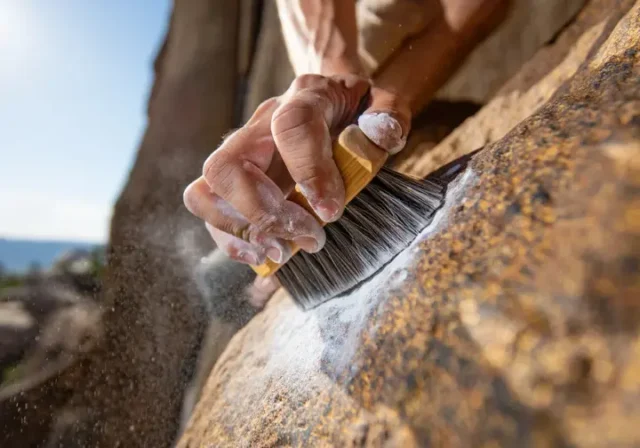In this article
The right rock climbing brush is more than just a cleaning tool; it’s a vital piece of climbing equipment that directly impacts your grip, safety, and success on the rock or climbing wall. This guide will help you understand the nuances of climbing brushes and choose the perfect one to maximize friction and conquer your projects. We aim to provide a comprehensive resource for dedicated climbers of all levels, fostering a deeper understanding and skill development in gear selection and sustainable practices. You’ll learn how brushing enhances friction, discover different brush types, get expert recommendations for your next actual climbing brush, and understand brushing etiquette.
The Science of Stick: Why Brushing Holds is Crucial for Climbers
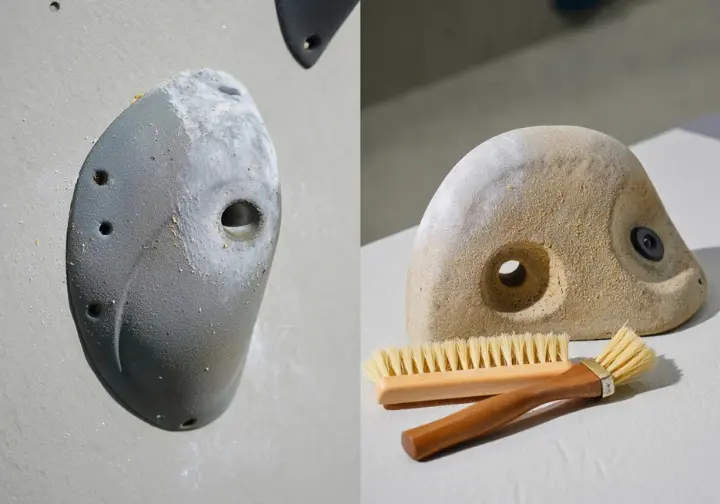
This section delves into the fundamental reasons climbers use brushes, explaining how clean climbing holds directly translate to better grip, enhanced safety, and a more confident climbing experience. We’ll explore the science behind friction and the detrimental effects of common hold contaminants. Understanding rock climbing brushes and their impact on grip is key for every climber.
Friction Fundamentals & the Enemy: Debris on Holds
Climbing fundamentally relies on the coefficient of friction between your hands or shoes and the hold surface; a clean surface is paramount for maximizing this interaction. Over time, holds accumulate a variety of contaminants such as chalk, skin oils, shoe rubber, and environmental dirt. These substances fill in the micro-textures of the climbing holds, significantly reducing friction and making them feel slick or “greasy” – a clear sign that some cleaning climbing action is needed. While chalk is used to absorb sweat, excess chalk can be counterproductive when it builds up, clogging essential textures and even polishing the hold surface over time. Proper brushing with a dedicated climbing brush meticulously removes this excess accumulation, restoring the hold’s natural texture and enabling optimal grip.
A primary culprit in reducing friction is the skin oils and sweat secreted by climbers, which create a slippery layer on holds. Effective brushes, particularly those hair-equipped brushes with absorbent bristles like boar’s hair, are adept at managing these greasy residues. Furthermore, small particles of shoe rubber wear off and adhere to holds, a common issue on frequently used routes or indoor climbing walls, further diminishing available grip. To effectively remove caked-on rubber and stubborn chalk from a chalk-covered climbing hold, stiffer bristles might be necessary. Outdoors, on real rock, ambient dirt, dust, and biological growths such as moss or lichen also coat hold surfaces, obscuring crucial features and reducing friction. Different types of debris often necessitate varied cleaning approaches to restore the hold as closely as possible to its original, grippy texture. For a deeper dive into the science of climbing friction, understanding these principles is key. Learning about how climbers perceive hold surfaces can also provide valuable insights.
The simple act of brushing is not merely about cleanliness; it’s a direct contributor to a climber’s ability to maintain secure contact with the rock. This, in turn, influences both physical execution and psychological confidence. Dirty, unreliable holds can necessitate greater physical exertion or, worse, lead to unexpected slips, which can undermine a climber’s mental composure and flow. Grasping these friction principles helps climbers recognize the reasons for brushing climbing holds diligently, justifying the need for specialized tools designed to tackle specific types of debris for enhanced performance and safety, distinguishing a good brush from a bad climbing brush.
Rock Preservation & Climbing Ethics: The LNT Approach to Brushing
The type of rock you are climbing on significantly dictates your brushing approach. Granite, sandstone, and limestone each possess varying degrees of hardness and are differently susceptible to damage or polishing from brushing. For instance, soft rock such as sandstone is particularly vulnerable. Even artificial gym holds, while generally durable, can be damaged by overly aggressive or inappropriate brushing techniques with the wrong climbing brush. The Leave No Trace (LNT) principles are paramount in climbing, and responsible brushing is a cornerstone of this ethic. This means cleaning climbing holds in a manner that minimizes impact, preserving the rock’s integrity for future climbers. Using an overly stiff brush (like hard nylon or, especially, a wire brush) on soft rock such as sandstone can cause irreversible damage by removing sand grains and altering the hold’s structure. This underscores why bristle material choice is so critical.
Brushing etiquette extends beyond your personal climbing attempts. It is considered good practice to brush holds before you depart an area or bouldering area, meticulously removing excessive chalk and any tick marks you may have made. This preserves the natural appearance of the rock and upholds the challenge for subsequent climbers. This is a key aspect of bouldering etiquette and brushing. In climbing gyms, brushing shared holds after your use, especially if you’ve left them heavily chalked or greasy, is the mark of a considerate climber and helps maintain optimal conditions for everyone. It’s also important to return any communal brushes to their proper place. You can review general gym climbing etiquette for more on this. The overarching goal of brushing should always be to restore the hold to its natural state, not to aggressively alter it or inadvertently create new features. This responsible approach, a form of stewardship and rock preservation, ensures the longevity of our precious climbing resources, both natural and artificial stones. Some climbers also consider the environmental impact of the brush itself, such as microplastics shed from nylon brushes, leading them to opt for biodegradable natural bristles like boar’s hair or horsehair, sometimes found in a wooden brush.
Anatomy of a Climbing Brush: Materials, Design, and What Matters for Performance
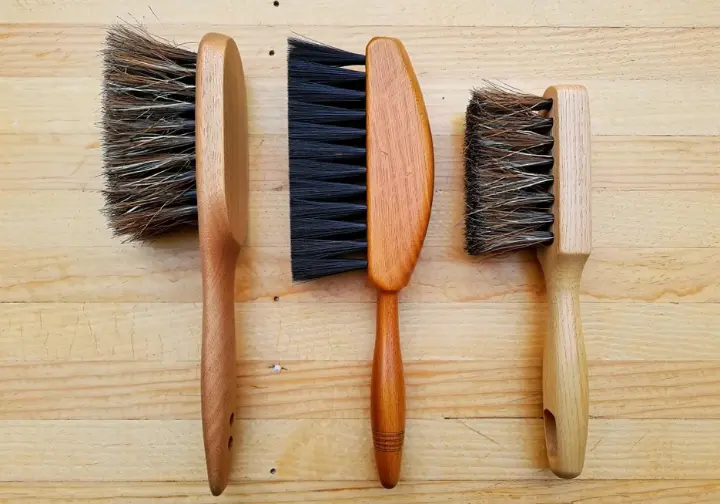
Not all brushes are created equal. This section breaks down the critical components of rock climbing brushes—bristle materials, handle ergonomics, size, and shape—explaining how each feature impacts cleaning effectiveness, durability, and suitability for different climbing scenarios when choosing the best rock climbing brushes based on their anatomy. Understanding the brush profile can make a significant difference.
Bristle Breakdown: Boar’s Hair vs. Nylon vs. Horsehair (and Synthetics)
The choice of bristle material is perhaps the most critical aspect of a climbing brush, directly influencing its cleaning power and impact on the rock. Boar’s hair is a natural bristle widely favored for its excellent balance of stiffness and flexibility. This makes it highly effective at removing chalk and grime while being relatively gentle on most natural rock types, such as granite and limestone. A significant advantage of boar’s hair is its ability to absorb oils and moisture, which are common culprits in reducing grip. Understanding boar bristle properties can highlight its suitability.
Nylon bristles, being synthetic, are typically stiffer and more durable than boar’s hair, and they are less prone to deforming when wet. However, their inherent stiffness poses a higher risk of polishing or damaging softer rock types. Consequently, nylon brushes are primarily recommended for very hard rock or for cleaning durable artificial gym holds. Horsehair bristles represent the softest natural option, making them ideal for cleaning very delicate or soft rock types like certain sandstones where minimizing any impact is paramount. They are, however, less durable than boar hair brushes or nylon when it comes to aggressive scrubbing. For a look at bristle types for different rock surfaces, there are resources available.
Other synthetic bristles are often marketed as “vegan” alternatives for vegan climbers, to animal-derived options. These aim to mimic the performance characteristics of boar’s hair, but their actual effectiveness and abrasion levels can vary significantly depending on the brand and the specific material used. Some of these synthetics may be less abrasive than standard nylon and could be suitable for gym holds or less sensitive rock. When comparing bristle materials, these nuances are important. Environmental considerations are also becoming increasingly important for many climbers. Natural bristles like boar’s hair and horsehair are biodegradable, whereas nylon bristles shed microplastics and are not biodegradable unless specified as recycled. The ethics of sourcing animal hair can also be a concern for some individuals.
Beyond the material itself, bristle density and stiffness are crucial factors. Higher density generally translates to more cleaning power. Stiffer bristles remove stubborn, caked-on debris but are also more abrasive. Therefore, a balance is needed based on the specific surface being cleaned. The lifespan of bristles varies: nylon is very durable, boar’s hair offers good durability, and horsehair, due to its softness, is the least durable. Uneven wear can occur over time, though some brush designs feature tapered bristles to help mitigate this issue and prolong the brush’s useful life.
Handle Design: Ergonomics, Materials, and Durability
Climbing brush handles are commonly crafted from wood, such as beech, bamboo, or maple, or from various types of plastic. There’s a noticeable and growing trend towards the use of recycled plastic brush handles for handles, reflecting an increased focus on sustainability within the climbing community. Wood and bamboo handles, like those on a wooden-handle brush, offer a natural, tactile feel and are often preferred for their eco-friendliness and aesthetic appeal. The thickness and curved shape of a handle can also affect comfort.
Ergonomics are crucial for both comfort and efficiency, especially during prolonged brushing sessions which are common when working a route or cleaning climbing holds thoroughly. Thoughtful design features such as angled heads or S-shaped handles can provide essential knuckle clearance, preventing the all-too-common “knuckle-bashing” against the rock or wall surface. Many ergonomic climbing brush handles prioritize this. Comfortably shaped grips, sometimes featuring indentations or dedicated thumb supports, allow for a more secure hold and help reduce hand fatigue. This is particularly important when you need to apply firm pressure to dislodge stubborn grime or caked-on chalk. Some might even prefer a grab-handle scrub brush design for certain applications.
Handle durability is another key factor to weigh. Robust plastics or quality hardwoods are significantly less likely to snap under pressure compared to cheaper, thinner materials often found in budget brushes. The method of bristle insertion methods also plays a role in the overall longevity of the brush, determining how well the bristles remain anchored in the handle during vigorous use. Sustainability is a significant consideration for many climbers. Handles made from sustainably sourced wood (e.g., FSC-certified) or recycled plastics are preferable to virgin plastics from an environmental standpoint.
Some handles cleverly incorporate additional features that enhance their utility. These can include a built-in scraper for tough spots, integrated sandpaper for callus care, hidden compartments for small items like skin balm (a climber’s friend!), or strategically placed holes for attaching to a chalk bag or an extendable pole with a protruding shaft for reaching higher holds. Ultimately, the overall design, encompassing handle length and thickness, should feel balanced in the hand. This balance allows for effective force transfer to the bristles without causing undue strain on the wrist or arm during use.
Size & Shape: Matching Your Brush to the Holds
Climbing brushes are available in a variety of sizes—typically small, medium, and large—and the “right size” is entirely dependent on the types of holds you most frequently encounter and need to clean. Small brushes, often distinguished by tapered heads, a narrow brush head, or chisel-like tips, excel at cleaning small crimps, pockets, and intricate rock features where precision is absolutely key. These compact tools can get into tight spots and tiny crevices that larger brushes simply cannot reach effectively. The Lapis brush, for example, is noted for its effectiveness on brushes for small features.
Medium-sized brushes are often considered the versatile all-around brush in a climber’s toolkit, suitable for a wide variety of hold types and representing a good starting point if you only want to invest in one brush initially. Many popular bouldering brushes fall into this category, offering a balance of coverage and precision. Large brushes, sometimes referred to as “sloper brushes,” are specifically designed for cleaning large surface area holds like slopers, volumes on indoor walls, and big natural features efficiently. Their wider bristle coverage cleans more major surface area with each stroke, saving time and effort on bigger holds.
The shape of the brush head also plays a significant role in its cleaning efficacy. Tapered heads or angled bristle cuts, for instance, help access deep pockets and crevices more effectively than a brush with a completely flat surface profile might. Some brushes are innovatively dual-ended, offering different bristle types (perhaps boar’s hair on one end and nylon on the other) or different sizes on a single handle for enhanced versatility. You might also find a video: brushing different holds useful for visual examples. Consider the specific morphologies of holds you’ll be cleaning climbing holds on. Jugs might be easy to clean with almost any brush, but thin cracks or tiny incut crimps demand a more specialized shape for effective cleaning of those critical contact surfaces. While a single, well-chosen medium brush can serve many purposes, numerous dedicated climbers eventually build a “quiver” of brushes, perhaps including some of their favorite brushes, with different sizes and shapes to tackle diverse terrain and hold types with maximum efficiency. Occasional brush head replacements might be a feature for some modular designs.
Mastering the Art: How to Choose and Use Your Rock Climbing Brushes Effectively
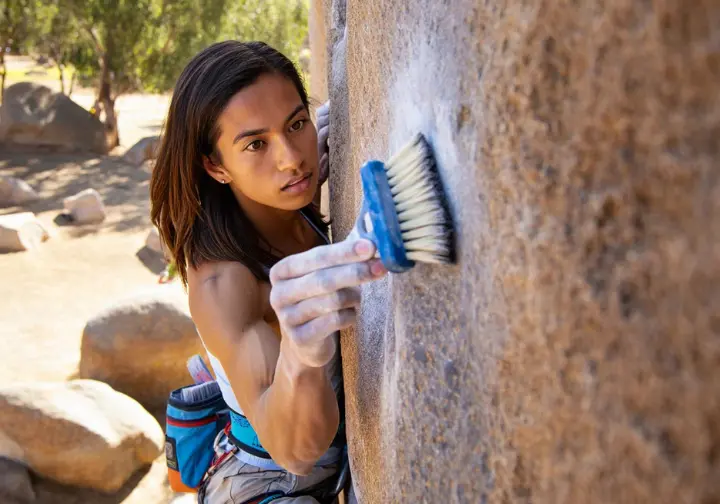
Selecting the right climbing brush is only half the battle; knowing how to use it properly maximizes its benefits for grip and rock care. This section provides a decision-making framework for choosing your ideal brush and offers tips on effective brushing techniques and essential crag/gym etiquette, focusing on techniques for using rock climbing brushes for max grip.
Step-by-Step: Choosing the Right Climbing Brush for Your Needs
First, assess your primary climbing environment: Are you mostly bouldering outdoors, sport climbing on natural rock, training in a gym at your local climbing gym, or a mix of these? This initial assessment will heavily influence your material and durability needs. If you’re primarily climbing outdoors, identifying the prevalent rock type in your areas (e.g., sandstone) like sandstone, granite, or limestone is a critical determinant for bristle choice to prevent damage. Softer rock like sandstone absolutely requires softer bristles (horsehair is often recommended), while harder surfaces and hard rock types can tolerate boar’s hair or even, cautiously, a nylon brush.
Next, consider the typical hold types you encounter on boulders or routes. Slopers, crimps, pockets, and jugs all benefit from different brush sizes and shapes for optimal cleaning. A large brush is efficient for expansive slopers, while a small, tapered one is ideal for tiny pockets. Reflect on your personal values. Do you prioritize sustainability, seeking out eco-friendly materials like bamboo or recycled plastic handles, and biodegradable bristles? Or are you looking for vegan options for vegan climbers, which would mean synthetic bristles?
Factor in any desired special features and your budget. Do you need an ergonomic handle for enhanced comfort during long cleaning sessions, proven durability for heavy use, an extendable pole for reaching high holds on boulders or routes, or integrated tools like sandpaper for callus care? Set a realistic budget based on these needs and priorities. Understand that a single “do-it-all” brush, even a classic brush, might not be optimal for all conditions or preferences. Many dedicated climbers gradually build a “brush quiver” with a few different types of climbing brushes to expertly suit varied rock, diverse hold types, and specific situations. Exploring the benefits of brushing for climbers can reinforce your selection criteria. For those interested in a hands-on approach, looking into DIY climbing brush considerations might offer alternative perspectives, though a purpose-built actual climbing brush usually performs best.
Finally, don’t overlook the importance of bristle density and stiffness in relation to the material. High-density boar’s hair is excellent for general cleaning on many surfaces, while very stiff bristles on a nylon brush are best reserved for durable gym holds or, with extreme caution, for the initial cleaning of new routes on very hard rock.
Brushing Techniques for Maximum Grip and Rock Care
To get the most out of your brush and protect the rock, employ gentle but firm pressure when brushing. The primary goal is to dislodge debris—chalk, skin oils, dirt, and rubber—not to aggressively scrub or wear down the rock surface, a particularly important consideration on natural formations. Use methodical back-and-forth strokes or small circular motions to effectively lift contaminants from the hold’s intricate texture. After dislodging the debris, ensure it’s actually removed from the hold by either blowing it away, letting the wind carry it, or gently flicking it off with the brush. Maximizing grip is the objective here. A helpful video: how to brush climbing holds can demonstrate these techniques. A good brush is more effective than just hand swipes.
Adapt your technique for different hold types. Slopers, for example, may require thorough, broad brush strikes to cover their larger surface area effectively and evenly. In contrast, small crimps and pockets demand precision, often best addressed using the tip or edge of a smaller, tapered brush to get into those tight spots. It’s also critical to avoid over-brushing, as this can polish holds over time, particularly on softer rock types or even on gym holds with excessive force. An efficient technique conserves energy and minimizes wear on both the hold and your brush, prolonging the life of both. You don’t want to be stuck brushing for longer than necessary.
When should you brush? Typically, brushing is done before your first attempt on a climb, between attempts (especially if you notice a decline in grip quality), and ideally, after you’re finished with a particular route or boulder problem. This last step is a courtesy to other climbers and helps maintain the climb in good condition. For heavily caked-on chalk or rubber, stiffer bristles (that are appropriate for the surface being cleaned) may be necessary. However, always start with the gentlest effective option to minimize any potential damage or undue wear. When cleaning climbing routes outdoors, particularly new ones or those with significant biological growth like moss or lichen, route developers might initially use stiffer tools for cleaning overgrown routes (sometimes even wire brushes, but this requires extreme caution and specific knowledge of rock types and conservation). For established routes, however, stick to appropriate climbing brushes to ensure no harm is done.
Brush Etiquette: Being a Good Crag and Gym Citizen
A fundamental aspect of climbing etiquette, deeply respected within the community, is to brush holds you’ve used, especially if you’ve significantly chalked them up or notice they’ve become greasy after your attempts. This simple act leaves them in good condition for the next climber, ensuring everyone has a better experience. When climbing outdoors, it’s crucial to remove any tick marks (chalk marks indicating holds or sequences) before you leave the bouldering area or crag. This practice preserves the natural appearance of the rock and, importantly, maintains the challenge of on-sighting for others who follow. This applies to well-chalked boulders and popular boulder problems alike.
If someone is working on a project and has just brushed the holds, it’s courteous to allow them the next attempt. If you do climb it before them, re-brushing it for them afterward is a considerate gesture. Good communication in these situations can prevent misunderstandings and foster a positive crag atmosphere. You can find many forum discussions on bouldering brushes etiquette that echo these sentiments. In climbing gyms, if communal brushes are provided, use them respectfully and always return them to their designated place so others can find them when needed. Avoid monopolizing communal brushes, especially during busy times.
Be mindful of where dislodged chalk and debris fall, particularly in crowded areas or when brushing holds that are situated above other climbers or their gear. A little awareness goes a long way in keeping gear clean and avoiding startling others. For new climbers, don’t feel awkward about brushing, even on easier routes; there’s often discussion around when new climbers should use brushes. Brushing is a standard and appreciated practice that benefits everyone by maintaining hold quality and demonstrating respect for the shared resource, be it rock or plastic. These practices not only contribute to a positive community atmosphere but also directly align with Leave No Trace principles, reinforcing responsible outdoor recreation habits and addressing the ethics of brushing on soft rock.
Top Rock Climbing Brushes of 2025: Picks for Every Climber and Terrain
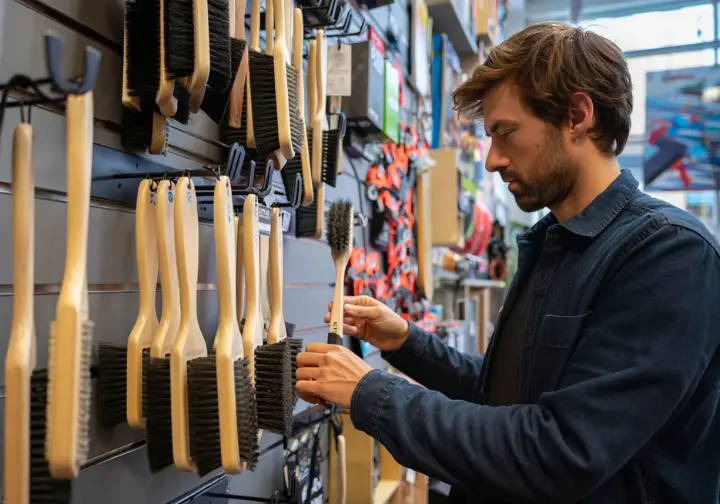
Based on extensive research and defined expert criteria—including cleaning effectiveness, bristle quality, durability, ergonomics, rock/hold friendliness, and value—here are our top rock climbing brush recommendations for various needs and climbing styles. This is our view of the current brush world.
Best All-Around Bouldering Brush
For versatile performance indoors and out, on varied holds. This is often the first individual brush a boulderer buys.
Metolius Razorback Boar’s Hair Brush | Secure ergonomic grip, dense boar’s hair, tapered for nooks
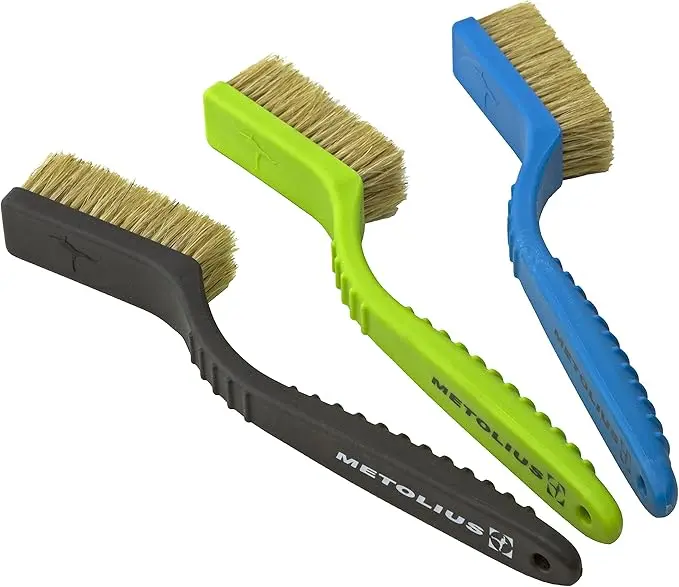
The Metolius Razorback Boar’s Hair Brush is a high-performance tool designed for effectively cleaning climbing holds from chalk and debris in both rock climbing and bouldering. Its standout feature is the densely packed boar’s hair bristles, offering maximum cleaning power; these are tapered with longer front bristles for longevity and effective scrubbing of small edges and nooks. Boar’s hair is favored for being gentle on rock, preserving texture compared to harsher synthetic bristles. The handle is another strong point: made of plastic with an ergonomic, ribbed design, it ensures a secure grip and provides good knuckle clearance, preventing scrapes during vigorous cleaning. Its square brush head enhances access to crevices, and it includes a hole for attaching a cord to a chalk brush climbing setup or harness.
Reason to Buy: The Metolius Razorback is an excellent choice for climbers seeking an affordable, rock-safe brush with an ergonomic design that excels at precise chalk removal and cleaning small to medium-sized holds effectively, a true workhorse among climbing brushes.
PROS
- Dense boar’s hair cleans chalk and light debris effectively.
- Ergonomic, ribbed plastic handle offers excellent grip and knuckle clearance.
- Tapered bristles and square brush head enhance cleaning in nooks and improve longevity.
- Rock-safe boar’s hair is gentle on natural rock and affordable.
CONS
- Bristles may shed after several months of heavy or aggressive use.
- Plastic handle can crack if dropped hard on rock surfaces.
- Less effective for caked-on dirt or heavy mud compared to stiffer nylon brushes.
- Relatively small bristle area can make cleaning large slopers time-consuming.
Best Brush for Outdoor Natural Rock (General Hard Rock)
Prioritizing rock preservation and effective cleaning on granite, limestone, etc. For outdoor boulderers on hard rock, this type of brush is essential.
Metolius Boar Brush (Bamboo Handle) | Lightweight, stiff boar’s hair, sustainable bamboo handle
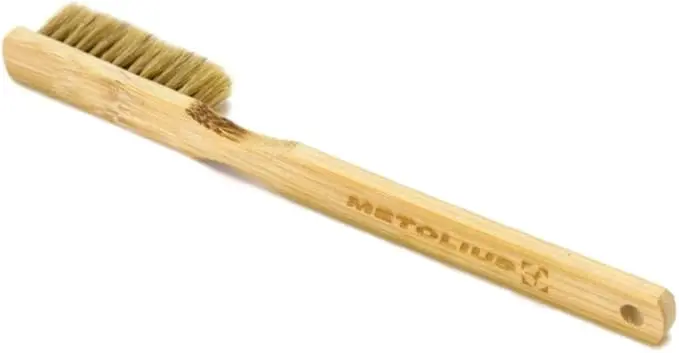
The Metolius Bamboo Boar’s Hair Brush appeals to climbers looking for an effective cleaning tool with an eco-friendly design. It features stiff, densely packed boar’s hair bristles that are adept at removing chalk and light debris from holds. Importantly, these bristles are gentle on natural rock surfaces like granite and limestone, helping to preserve their texture. The handle of this wooden brush is crafted from natural bamboo, making it lightweight, sustainable, and comfortable to hold. A hole for cord attachment allows for easy portability on a chalk bag or harness.
Reason to Buy: This brush is ideal for eco-conscious climbers who need a lightweight, rock-safe boar’s hair brush primarily for chalk removal on harder rock and appreciate the natural aesthetic of a bamboo handle. A great all-around brush for many climbs.
PROS
- Stiff, densely packed boar’s hair cleans chalk effectively while being rock-safe.
- Lightweight design at approximately 0.5 oz (14 g).
- Sustainable and aesthetically pleasing natural bamboo handle.
- Affordable price point, offering good value.
CONS
- Bamboo handle may splinter or crack if dropped or repeatedly exposed to moisture.
- Handle lacks ergonomic ribbing (like the Razorback), potentially reducing grip security, especially when wet.
- Bristle shedding can occur with heavy or prolonged use.
- Small bristle area is less efficient for cleaning very large holds or widespread chalk.
Best Brush for Soft Rock (e.g., Sandstone)
Specialized for delicate rock where minimizing impact is paramount. These brushes are key for preserving fragile rocks.
Lapis Wood Boar’s Hair Brush | Dense boar’s hair ideal for sandstone, precise cleaning

The Lapis brush is a premium brush often chosen by climbers who frequent areas with softer or more delicate rock types, such as certain sandstones. It features densely packed boar’s hair bristles, which, while not as soft as horsehair, are designed in this model to be effective for chalk removal without unduly polishing or damaging these sensitive holds. Users report it is “gentle on rock” and particularly “ideal for sandstone”. A key design aspect is that the bristles extend to the very edge of the handle, facilitating precise cleaning of small crimps, edges, and tiny huecos. The handle is typically made from stiff beechwood with a concave design for optimal contact pressure, though a classic plastic handle version also exists; both include a cord hole. How this premium brush performs is notable.
Reason to Buy: The Lapis Wood Boar’s Hair Brush is a top-notch choice for discerning climbers who need a high-quality, precise brush for effective chalk removal on soft or delicate rock, provided they use a gentle scrubbing technique to preserve the handle.
PROS
- Dense boar’s hair bristles provide effective chalk removal while being gentle on soft rock like sandstone.
- Bristles extending to the handle edge allow for precise cleaning of small or intricate holds.
- Durable bristle construction generally holds up well to frequent use if handled correctly.
- Offers good versatility for both indoor and outdoor bouldering and route climbing.
CONS
- The handle (both wood and plastic versions) has a tendency to flex and can break at the neck with aggressive scrubbing or if too much pressure is applied.
- Some users report bristle shedding, particularly after extended heavy use.
- The brush area is relatively small, making it less efficient for cleaning large slopers or expansive surfaces.
- Comes in random color selections, which may not appeal to all buyers.
Best Extendable Climbing Brush / Stick Brush
For reaching high holds in bouldering or on routes. Some boulderers find these tools invaluable.
Mammut Brush Stick Package | Integrated stick and brush solution from a major brand
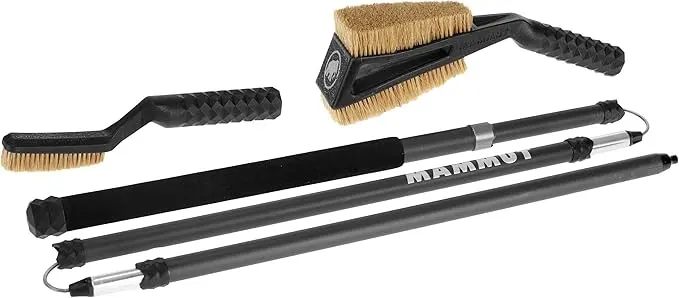
The Mammut Boulder Brush Stick Package (often referred to as part of the Mammut Boulder line) is an innovative and comprehensive kit designed for climbers needing to clean hard-to-reach holds, whether high on a boulder or distant on a sport route. The package includes a lightweight telescopic carbon fiber shaft and two distinct, attachable boar’s hair brushes: a larger Sloper Brush for bigger surfaces and a smaller Crimper Brush for more precise work. The boar’s hair bristles are gentle on rock, suitable even for softer surfaces like sandstone. A standout feature is the carbon stick, extending from a compact 40 cm (15.7 in.) to a lengthy 120 cm (47.2 in.); it’s ultralight yet robust and cleverly doubles as a trekking pole, complete with a base spike, making it useful for approaches. The brush handles are also made from recycled plastic, adding an eco-friendly element.
Reason to Buy: The Mammut Brush Stick Package is an excellent investment for dedicated boulderers and sport climbers who frequently encounter out-of-reach holds and value a high-quality, versatile tool that can also assist with approaches. It’s more than just a chalk brush; it’s a system.
PROS
- Telescopic carbon stick provides excellent reach for high or distant holds.
- Includes two specialized boar’s hair brushes (Sloper and Crimper) for versatile cleaning with a versatile brush head concept.
- Stick doubles as an ultralight trekking pole, adding value and utility for approaches.
- Uses rock-safe boar’s hair and recycled plastic in brush handles, appealing to eco-conscious climbers.
CONS
- Premium price point (around $50-$60) makes it a significant investment.
- The stick’s locking mechanism may loosen over time with repeated use.
- Brushes can occasionally detach from the stick during vigorous cleaning if not secured tightly.
- The Crimper Brush is considered too small by some users, offering limited leverage for aggressive scrubbing.
Conclusion: Brush Up Your Climbing for Peak Performance
The right rock climbing brush is a critical tool for enhancing grip, ensuring safety, and improving overall climbing performance by keeping holds clean of chalk, oil, and debris. Choosing a brush involves understanding bristle materials (boar’s hair, nylon, horsehair), handle ergonomics, and size/shape in relation to your primary climbing environment (gym, specific rock types) and the holds you’ll encounter. Prioritize brushes that match your specific needs, whether it’s an all-around bouldering brush, a soft brush for delicate sandstone (perhaps from brands like Sublime brushes or a specific Lapis brush), a durable option for the gym, or an eco-friendly choice. Effective brushing technique and adherence to climbing etiquette (like cleaning climbing holds and removing tick marks) not only benefit your climbing but also contribute to rock preservation and a positive community spirit. By investing in appropriate brushes and using them wisely, you foster a deeper connection with your gear and the climbing environment, aligning with this blog’s mission to promote skill development and sustainable practices.
Frequently Asked Questions about Rock Climbing Brushes
What’s the main difference between boar’s hair and nylon climbing brushes? >
How often should I brush climbing holds? >
Can I use a regular toothbrush as a climbing brush? >
Is it okay to use a wire brush on climbing routes? >
We are a participant in the Amazon Services LLC Associates Program, an affiliate advertising program designed to provide a means for sites to earn advertising fees by advertising and linking to Amazon.com. As an Amazon Associate I earn from qualifying purchases. We also participate in other affiliate programs. The information provided on this website is provided for entertainment purposes only. We make no representations or warranties of any kind, expressed or implied, about the completeness, accuracy, adequacy, legality, usefulness, reliability, suitability, or availability of the information, or about anything else. Any reliance you place on the information is therefore strictly at your own risk. Additional terms are found in the terms of service.



